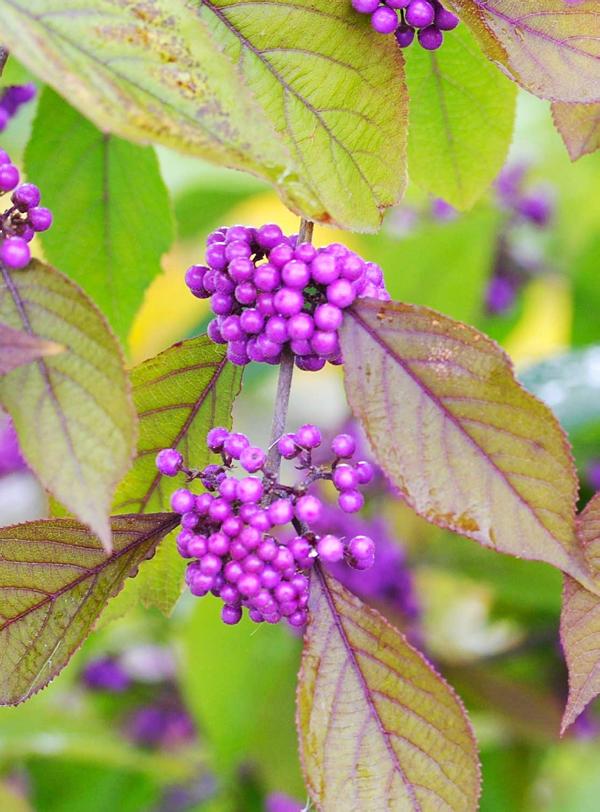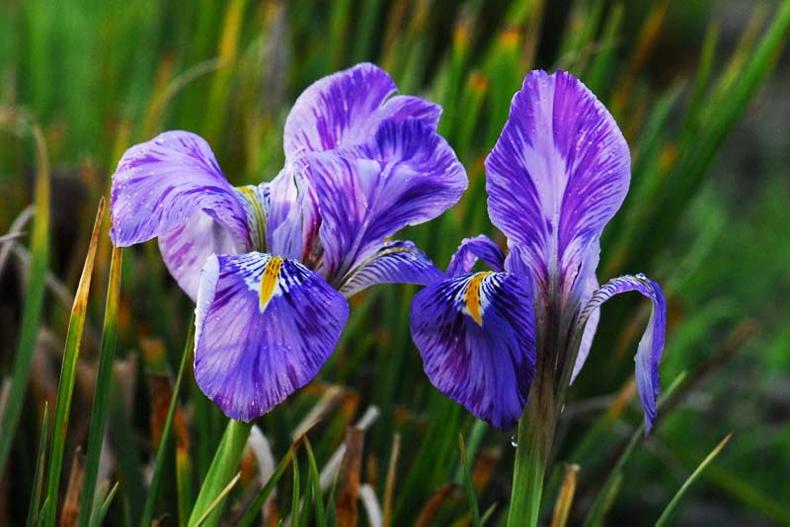The common name of callicarpa is beauty berry and it is one of the rare-enough cases where the common name of a plant means the same as the botanical name.
Callicarpa means beautiful fruit and nicely describes the shrub which carries dense rounded clusters of small purple berries. These are round with a sheen on the surface and resemble beads, but the colour is intense and the clustering of berries gives them strength and visibility. The berries are carried at the point where the leaves are attached to the stem.
The leaves are carried in opposite pairs and the berries are clustered at the same point. In summer, the leaf axils carry clusters of small pink flowers, but these are too small and too much hidden by the leaves to be of decorative value. However, they are soon followed by the berry clusters.
In turn, the berries are not so noticeable until they colour from green, turning purple. Even then, the clusters of berries are not obvious until the leaves colour. The colouring of leaves can be really beautiful as they mostly turn to a shade of soft gold, many of them with varying degrees of a flush of purple, the same colour as in the fruits.
Even when the leaves fall and just lie on the ground around the shrub, the combination of soft gold and purple is very decorative. Interestingly, the purple colour of the berries is very similar to the purple flowers of other members of the same family, the verbena family. It can be compared to the flower colour of the purple-top verbena, for instance.
Callicarpa can be planted with other berrying shrubs nearby and the colour of the fruits shown off by contrast with the others in the red, orange and yellow range. But it is probably best on its own with spring-flowering shrubs that have finished months ago and now just offer foliage background, or a pattern of twigs later on when leaf-fall has taken place. It can make a big bush to well over two metres, so it is not a shrub for small spaces. It might suit a rural garden nicely, given room to grow and make its dramatic autumnal show.
The variety most often offered for sale is Profusion, a choice strain with purplish young leaves in spring and more of a red/purple flush in the autumn leaves before they fall. It also carries a good crop of berries reliably. The crop of berries varies from year to year in accord with the amount of sunshine. There are many more berries after a sunny summer, or, better still, a succession of good growing years.
The plant is native to western China and it is hardy in most conditions, but the summers of its native region are much warmer than here and it is important to provide a sunny, sheltered position for best results. Although it is self-fertile, it sets more berries reliably when there other plants nearby.
However, this is unlikely in an ordinary garden, given the space that a single shrub can take up. There is also the fact that available plants are usually only of the variety Profusion, which is propagated by cuttings and all plants propagated in this way are essentially the same plant and offer no different pollen for fruit production.
This shrub will grow well in ordinary fertile soil, well-drained and not prone to water-logging in winter. Use a mulch of rotted leaves to keep down weeds, supply some nutrients and retain moisture in summer.
Picking pears
Pears are much more difficult to grow than apples. They need really good conditions to grow well. Yet home-grown ripe pears are incomparable in taste compared to any shop-bought pear. This is not just down to varieties because the main home-grown pear, conference, is also commercially important. Part of the art of growing pears is picking them at the right time and ripening them for eating.
Unlike apples, pears do not ripen on the tree. In natural conditions, they fall and ripen on the ground. Pick pears when they appear ripe and the first few fall to the ground. Then ripen them in a shed or cool room, testing one every few days. Some take a couple of weeks, others several weeks. Start using them as soon as they soften enough to eat as they will continue to soften.
Trees, shrubs and roses
Planting of all kinds of bare-root and root-ball deciduous trees, hedging and shrubs can continue in good weather, and all kinds of pot-grown trees and shrubs can also be planted, of course. Do not plant into saturated ground or into planting holes that fill with water, because the wet conditions cause the roots to rot.
Fruit, veg and herbs
Plant new fruit trees and bushes – good quality plants are available in a very interesting range of varieties. Dig over vegetable ground, removing the old crops. Control weeds over areas of ground that you hope to cultivate later. Spread compost or rotted manure before digging or rotovating it in.
Flowers
Bedding plants for spring colour should be put in now, if not already done, clearing out old summer bedding from pots and flower beds. Lift dahlias, begonias and gladiolus in frosty localities to prevent damage, or cover them with soil in milder areas. Spring bulbs should be in by now and should soon be planted if not.
Lawn
Sulphate of iron lawn mosskiller can be used now. Moss will grow strongly in the coming months and can build up to damaging levels. Keep on mowing the lawn for as long as possible, if the soil is not wet and soft. Grass tends to grow a little over winter and an occasional mowing during dry weather will keep it neat.
Greenhouse and house plants
Remove all debris and dead plants and ventilate occasionally. Water little to reduce the risk of grey mould disease. Set up a greenhouse frost protection heater to protect tender plants, such as geraniums. On the lowest setting, this only comes on when frost threatens and so it doesn’t cost much.










SHARING OPTIONS